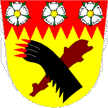![[semaphore positions]](../images/v/vxt-d1908.gif)
Semaphore Flags, USN (Sea Flags)
Please note with regard to 2), in British RN usage ships hoisted a designated semaphore flag to indicate that they were about to make a signal by means of the mechanical semaphore system - see 'semaphore flag'.
![[semaphore flag]](../images/v/vxt-d3675.gif)
Semaphore Flag - Flag F in the contemporary Naval Code, UK (fotw)
2) In vexillology as above – but see the note below.
![[a semy flag]](../images/v/vxt-d4442.gif)
![[semy]](../images/v/vxt-d4870.gif)
![[a semy flag]](../images/v/vxt-d2590.gif)
Flag of El Garrobo, Spain (fotw);
Flag of Widnau, Switzerland (fotw);
Former Flag of Alvalade, Portugal
(fotw)
Please note regarding 2), that in vexillology the term may be used even if the number and disposition of the charges are strictly determined as in, for example, the US national jack.


Arms of
Vodice, Slovenia (fotw); Flag of
Kampenhout, Belgium (fotw)
Notes
a) The word semeion had a broad range of meanings in classical
Greek all roughly corresponding to “sign” (see also ‘signum’) and it is accordingly
suggested that the definition given above (whilst based on written sources) must be considered to some
degree conjectural.
b) Semeia is the plural form of
semeion, and that classical
Greek writers also refer to “barbarian semeia” with those of the Phoenicians recorded as having been a globe and
crescent.
![[a semi flag]](../images/v/vxt-d1252.gif)
Flag of Wildberg, Switzerland (fotw)
![[example]](../images/v/vxt-d2755.gif)
![[example]](../images/v/vxt-d4871.gif)
![[example]](../images/v/vxt-d3287.gif)
Arms of Dobříň, Czechia (fotw);
Flag of Benkovac, Croatia (fotw):
Arms of Báhoň, Slovakia (fotw)
![[Senior Officer Afloat pennants]](../images/v/vxt-d293.gif)
![[Senior Officer Afloat pennants]](../images/v/vxt-d3518.gif)
![[Senior Officer Afloat pennants]](../images/v/vxt-d3636.gif)
Senior Officer Afloat Pennants, Argentina,
Estonia and Chile
(fotw)
Notes
a) There are many different designs than those shown above, and these might also have differing or additional meanings.
b) A green-white-green square-ended pennant – the starboard pennant in the NATO signal code - is used for this purpose (at the starboard yardarm) by all warships of the Alliance, but usually only when there is no flag officer present who is flying his flag afloat. It is, however, also employed to indicate the senior officer when ships of more than one NATO navy are present in a port, irrespective of whether any flags of command or broad pennants are flying.
![[Lancashire flag]](../images/v/vxt-d2968.gif)
Flag of Lancashire, UK (fotw)
![[separatist flag]](../images/v/vxt-d4919.gif)
Flag of the Hawar Islands Separatist Movement, Bahrain (fotw)
![[Serapis flag]](../images/v/vxt-d473.gif)
The Serapis/Franklin Pattern of Stars and Stripes, 1778 (fotw)
![[Sergeant Major’s Colours example]](../images/v/vxt-d2390a.gif)
![[Sergeant Major's Colours example]](../images/v/vxt-d2390b.gif)
Examples of Sergeant Major’s/Major’s Colours in Venn A and Venn B,
English c1641 (fotw)
Please note that these flags relate to the field officer whose rank was immediately below that of Lt Colonel, and not to a senior non-commissioned officer as is modern usage.
2) In heraldry see 'indented' and 'dancetty'.



Flag and Arms of
Milíkov, Czechia (fotw); Civil Ensign of
Taiwan 1929-1966 (fotw)
![[Postal flag - Norway]](../images/v/vxt-d407.gif)
Former Postal Ensign/Flag of Norway (fotw)
Please note with regard to 4) that a gold star (as illustrated above) or emblem indicates that the person being represented
has died in service.




Armistice Day Flag, US (fotw); Service Flags US (fotw); Canada (CS)



The DDR Shipping Inspectorate, 1955-90 (fotw); Lifesaving Service, US (fotw); Icebreaking Service, Denmark (fotw)
